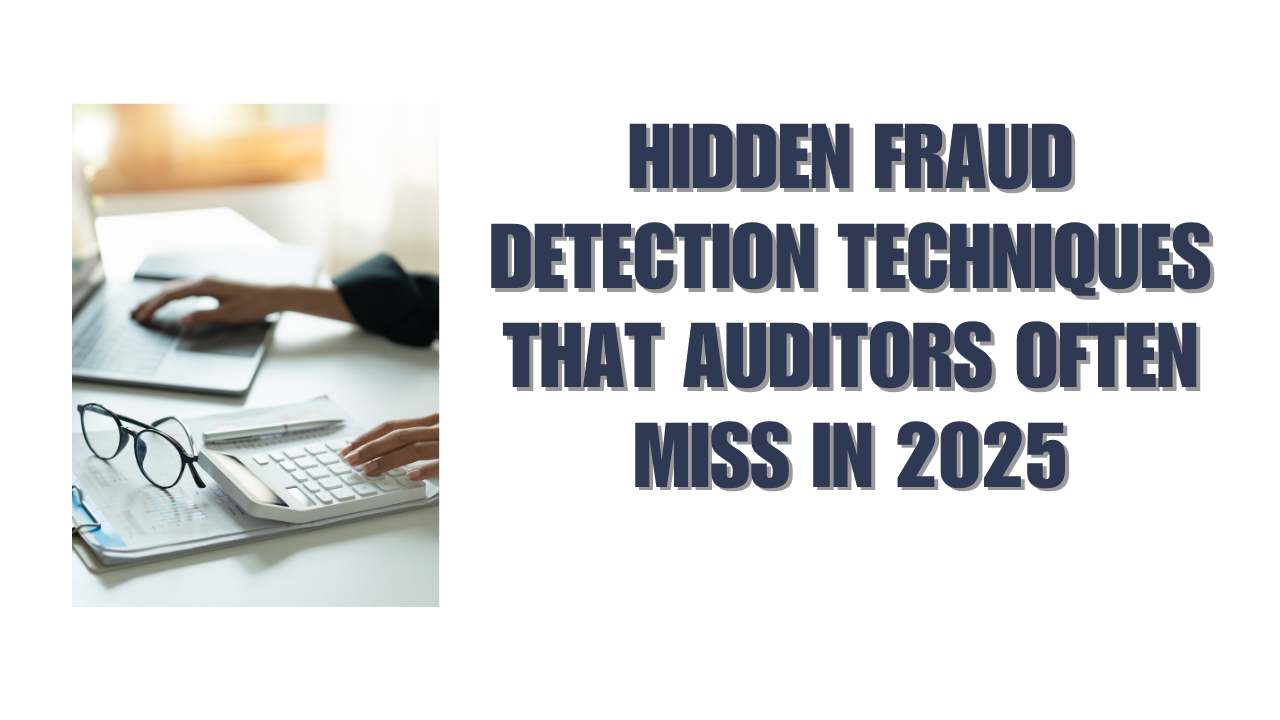Fraud detection techniques play a significant role in business operations, yet companies often overlook them. U.S. businesses lose up to $50 billion each year from internal theft. Corporate failures from fraud have happened throughout decades, but they make up just a small percentage of listed companies. This gap shows a worrying trend in fraud identification and prevention methods.
The 10-80-10 rule of fraud susceptibility reveals a stark truth about human nature. Only 10% of people stay honest no matter what, while 80% might commit fraud when they find the right mix of justification, chance, and motivation. Most cases of fraud come to light through external or independent sources rather than preventive measures. Traditional auditing methods often miss key forensic techniques such as data mining that could expose hidden financial discrepancies.
Modern tools like predictive analytics can use past data to spot potential fraud. Yet many audit teams stick to conventional methods. This piece will examine lesser-known fraud detection techniques in forensic accounting and detection approaches that can boost your organization’s defense against financial fraud threats.
Overlooked Behavioral Indicators in Fraud Detection
Behavioral indicators tell a more compelling story than financial data alone in fraud detection. The Association of Certified Fraud Examiners (ACFE) found that 85% of fraudsters showed recognizable behavioral red flags before anyone found their crimes. Notwithstanding that, management and colleagues often miss or dismiss these vital warning signs.
Unusual Role Changes and Access Rights
Staff members with control issues pose an overlooked fraud risk. Their refusal to share duties or take leave should raise immediate red flags. People who work longer hours than their peers without clear justification might create opportunities to commit fraud without witnesses. ACFE data shows that reluctance to share duties appeared in 15% of fraud cases. This makes it a vital indicator for auditors to track.
Control-obsessed behaviors show up through unusual activities. Staff members might ask for detailed information about planned internal audit scopes. They could request audit delays “to properly prepare” or build new relationships with other departments. These patterns often point to attempts at bypassing security measures. Teams that monitor access rights and role changes can spot potential fraud early.
Sudden Lifestyle Shifts in Mid-Level Employees
Living beyond means ranks as the most common behavioral red flag. It shows up in 42% of fraud cases. This indicator has topped every ACFE study since 2008. New luxury cars, expensive trips, or big purchases that don’t match known income deserve investigation.
Mid-level managers face the highest fraud risk. Studies show that professionals aged 35-45 who know their organization well and maintain tight control become frequent offenders. They usually have enough authority to bypass controls but face less scrutiny than executives.
Sharp observers notice employees who seem stressed without obvious reasons or show sudden changes in lifestyle and social behavior. ACFE data reveals that financial difficulties appear in 63% of cases. These money problems can push people toward fraud to ease their economic pressure.
Repeated Policy Bypasses and Justifications
Staff who regularly ignore established protocols raise another often-missed warning sign. They might skip approval steps, switch to suppliers they know personally, or avoid implementing internal safeguards.
ACFE reports show irritability, suspicion, or defensiveness in 13% of fraud cases. Someone who becomes overly secretive about their work or reacts aggressively to questions might hide fraudulent activities. Rising complaints about specific employees or frequent rule-breaking also needs closer attention.
These indicators become especially challenging because they connect with each other. Staff members who delay data sharing or give different answers to different stakeholders often try to hide something. Auditors who recognize these behavior patterns can catch potential fraud schemes before serious damage occurs.
Benford’s Law and Other Statistical Anomalies Auditors Ignore
Statistical methods are great tools to uncover fraud that regular audit procedures miss. Benford’s Law stands out as an effective but underused technique to spot number manipulation.
First-Digit Distribution in Expense Reports
Benford’s Law shows a surprising fact about natural numbers: legitimate datasets have the first digit “1” about 30% of the time, while “9” shows up only 4.6% of the time. This mathematical rule gives auditors a reliable way to spot suspicious expense reports. Data that substantially deviates from Benford’s expected patterns often points to manipulation.
To cite an instance, expense reports with too many numbers starting with “5” or “6” need a closer look. People who commit fraud tend to create numbers that feel random but comfortable—this breaks natural distribution patterns. This simple analysis catches discrepancies that regular sampling often misses.
Auditors can use first-digit distribution to:
- Spot made-up expenses without heavy computing
- Focus their investigation on statistically suspicious transactions first
- Find patterns that regular audits miss
Outlier Detection in Vendor Payments
Vendor payment analysis through outlier detection is another statistical method audit teams often overlook. This method spots transactions that don’t fit established patterns by using standard deviation and interquartile range.
Transactions beyond three standard deviations or outside 1.5× interquartile range need investigation. Many audit protocols don’t even use these simple statistical tests. Time-series analysis of payments can reveal suspicious patterns—like amounts just under approval limits or odd payment timing—that standard checks miss.
The best outlier detection looks at multiple factors:
- Unusual transaction amounts
- Strange timing
- Odd frequencies
- Patterns between vendor’s and approver’s relationships
Regression Analysis for Pattern Deviation
Regression analysis is a powerful statistical tool that fraud detection teams rarely use. This method creates expected relationships between variables and sets a baseline to check transactions.
Regression models can predict normal patterns between:
- Invoice amounts and past records
- Payment timing and business seasons
- Expense types and department activities
Transactions that don’t match regression predictions need a closer look. Many audit teams lack either the stats knowledge or the right software to use these methods well.
Regression’s real value lies in its ability to handle normal business changes. These models can account for seasonal shifts, growth trends, and other factors that might cause false alarms. Yet auditors often stick to simple threshold rules instead of using these smarter approaches.
Adding these statistical methods to regular audits creates a strong system to catch potential fraud. Setting up these methods might need extra skills and resources at first. The benefits become clear when you compare setup costs against fraud losses. Organizations remain vulnerable to fraud until audit teams start using these statistical approaches fully.
Digital Forensics Techniques Often Skipped in Routine Audits
Digital forensics offers specialized yet often overlooked ways to uncover complex fraud schemes. These methods go beyond regular audit procedures to find digital evidence that standard approaches don’t catch.
Email Header Analysis for Internal Collusion
Email headers contain metadata that reveals much more than the message itself. This data is a great way to get evidence when investigating possible collusion between employees. The headers show exactly who talked to whom and the IP addresses and servers that handled the message.
Forensic experts can get this data through different methods based on the email client:
- In Gmail: clicking the down arrow next to Reply and selecting “Show Original”
- In Outlook: accessing Properties through the File tab and viewing Internet headers
- In AppleMail: enabling “Show additional message headers” in priorities
The header analysis can spot signs of fraud:
- “From” address domains that don’t match the sending server
- Unusual routing paths
- Failed SPF, DKIM, or DMARC authentication
- Time gaps between sending and receiving
Log File Tampering Detection in ERP Systems
ERP systems keep detailed logs of user activities that create digital footprints for every transaction. Smart fraudsters try to hide their tracks by changing system logs. Most auditors don’t check these changes carefully enough.
Companies can protect their log integrity through several measures:
- Set up system log table protection rules to limit changes
- Create blocks and logs for unauthorized access attempts
- Keep track of critical tables like syslog, sys_audit, and protected_table_configuration
Attackers might turn off monitoring to hide what they’re doing. Alert auditors should look for these warning signs:
- Sysmon driver getting unloaded
- Cleared event logs
- Disabled event tracing
- Direct changes to log integrity
Metadata Examination in Financial Documents
A document’s metadata acts like a silent witness to prove if it’s real. This information tracks when files were created, changed, and opened—and shows who did what.
A full metadata check looks at several key things:
- Timestamp Analysis: Comparing when files were created, changed, and accessed to check if the timeline makes sense
- File Size Verification: Making sure file sizes match what they should be
- Format Validation: Checking if file formats are what they claim to be
Forensic tools can spot attempts to change metadata. Reverse steganography helps find hidden data in digital files, while stochastic forensics can piece together digital activity that barely leaves a trace. Cross-drive analysis connects information from multiple sources, which helps catch complex fraud schemes with multiple people involved.
These digital forensic methods find important evidence that regular audits miss, helping organizations catch and stop fraud better.
Fraud Detection Tools and Techniques Underutilized by Audit Teams
Software tools are the life-blood of modern fraud detection but many audit teams don’t use them enough. These technologies have showed remarkable success in finding financial irregularities. Research shows that digital analysis software and data mining tools rank among the least used anti-fraud methods because teams lack resources and familiarity.
CaseWare IDEA for Transaction Pattern Analysis
Caseware IDEA stands out as a detailed data analysis solution that audit experts designed to detect anomalies, trends, and patterns in financial data. Many audit teams fail to employ its full potential. This powerful tool helps auditors to:
- Perform fuzzy join analysis between databases to test for possible duplicates
- Conduct sentiment analysis and word frequency examinations
- Apply 100+ smart audit tests for faster, detailed analysis of general ledgers
IDEA excels at analyzing large datasets during fraud investigations without tipping off suspects. The software identifies unusual patterns in payroll, purchases, and banking—three areas where fraud commonly occurs. It also applies Benford’s Law principles to spot statistical irregularities in numerical data, a technique that forensic accountants call one of the most effective ways to uncover manipulation.
AI-Based Anomaly Detection in ACL Analytics
ACL Analytics uses advanced machine learning methods to identify anomalies and patterns of fraudulent activities in financial data. This highly effective technology remains underused. The AI capabilities help audit teams to:
ACL Analytics includes predictive scoring models that ended up improving fraud detection rates by 35% while simultaneously reducing false positives by 18%. Organizations should think over the cost/benefit trade-off, as the original investment typically pays off through fraud prevention.
Real-Time Alerts via SAS Fraud Management
SAS Fraud Management offers end-to-end fraud detection capabilities with up-to-the-minute monitoring across multiple channels and business lines from a single platform. The system’s ability to process transactions in milliseconds is vital since fraud detection systems have very little time to assess risk before organizations face the tough task of recovering fraudulent payments.
The system uses a signature-based approach that captures customer behavior from multiple sources and analyzes patterns and inconsistencies with each transaction. Organizations using SAS solutions report major improvements, including 40% reduction in case alert volume among the previously mentioned improvements in detection rates.
Internal Tip-Off Systems and Whistleblower Data Auditors Miss
Tips are the most powerful yet underused resource for detecting fraud. 43% of fraud cases come to light through tips, while internal audits catch only 14%. Auditors often miss key elements in internal reporting systems that could catch fraud earlier.
Unmonitored Internal Hotline Logs
Organizations with hotlines are twice as likely to detect fraud through tips compared to those without these systems. Many audit teams neglect to check these valuable logs regularly. The ACFE reports that organizations lose 5% of annual revenue to fraud on average, which adds up to NZD 8.53 trillion worldwide.
Email and web-based submissions have replaced traditional telephone hotlines as the preferred reporting channel. Organizations should offer multiple reporting channels to catch more fraud cases. About 70% of organizations now have whistleblower hotlines. Auditors rarely check if anyone monitors these systems properly.
Ignored Anonymous Email Submissions
Anonymous reporting mechanisms help people disclose fraud without fear. These anonymous channels often reveal schemes that might go unnoticed otherwise. Many employees avoid reporting suspicious activities through traceable channels. Without anonymous options, 29% report to direct supervisors and 16% to executives.
Secure, identity-protected reporting methods work better than email since emails can reveal identities. Clear procedures must guide how teams handle and investigate these submissions.
Lack of Correlation with HR Exit Interviews
Exit interviews offer a valuable chance to discover potential fraud. Employees feel more comfortable sharing information about fraud when leaving the company. They often discuss activities they were scared to report while working there.
Most organizations don’t connect exit interview findings with fraud investigations or audits. Good exit interviews should include specific questions about violations of laws, regulations, and conduct codes. Detailed interview records help defend against external investigations. Well-conducted exit interviews can spot compliance issues early and lower the risk of external whistleblower actions.
Conclusion
Fraud detection needs a multi-layered approach that goes way beyond traditional audit methods. This piece explores several overlooked techniques auditors should add to curb financial fraud effectively. Behavioral indicators need more attention, as 85% of fraudsters show recognizable warning signs before they’re caught. These signals combined with statistical methods like Benford’s Law give us powerful tools to identify numerical manipulation that regular sampling methods miss.
Digital forensics adds extra protection against sophisticated fraud schemes. The combination of email header analysis, log file tampering detection, and metadata examination helps uncover evidence that traditional approaches miss. Audit teams who don’t use these methods leave their organizations open to major financial damage.
Software tools play a vital role in detailed fraud detection. CaseWare IDEA, ACL Analytics, and SAS Fraud Management provide powerful features that boost detection rates while cutting down false positives. Yet many organizations don’t use these technologies because of limited resources and lack of familiarity.
Tips and whistleblower reports are the best fraud detection method, accounting for 43% of discovered cases compared to just 14% through internal audits. Organizations with strong reporting systems and well-monitored whistleblower hotlines protect themselves better than those using only conventional audit procedures.
Fraud keeps evolving, and auditors must adapt their techniques. Smart organizations should implement detailed detection strategies that blend behavioral analysis, statistical methods, digital forensics, specialized software, and effective tip-off systems. This all-encompassing approach helps identify fraud better and deters potential fraudsters. Your organization’s financial health depends on moving beyond traditional audit methods to embrace these sophisticated detection techniques.
Key Takeaways
Modern fraud detection requires auditors to look beyond traditional methods and embrace sophisticated techniques that can uncover the $50 billion in annual losses from internal theft.
- Monitor behavioral red flags closely – 85% of fraudsters display recognizable warning signs like living beyond means (42% of cases) and refusing to share duties before discovery
- Apply statistical analysis tools – Benford’s Law and outlier detection reveal numerical manipulation patterns that conventional sampling methods consistently miss
- Leverage digital forensics techniques – Email header analysis, log file tampering detection, and metadata examination uncover sophisticated fraud schemes traditional audits overlook
- Utilize underused fraud detection software – Tools like CaseWare IDEA and ACL Analytics improve detection rates by 35% while reducing false positives by 18%
- Prioritize tip-off systems and whistleblower data – Tips uncover 43% of fraud cases compared to only 14% via internal audits, making hotlines and anonymous reporting crucial
The most effective fraud prevention combines behavioral analysis, statistical methods, digital forensics, specialized software, and robust whistleblower systems. Organizations that implement this multi-layered approach not only detect fraud more effectively but also create powerful deterrents against potential fraudsters, protecting their financial health in an increasingly complex threat landscape.
FAQs
Q1. What are some behavioral red flags that auditors should look out for when detecting fraud?
Key behavioral indicators include employees living beyond their means, refusing to share duties, exhibiting sudden lifestyle changes, and repeatedly bypassing company policies. Auditors should pay close attention to these warning signs, as they are present in a high percentage of fraud cases.
Q2. What digital forensics techniques are often overlooked in routine audits?
Commonly overlooked digital forensics techniques include email header analysis for detecting internal collusion, log file tampering detection in ERP systems, and metadata examination in financial documents. These methods can uncover sophisticated fraud schemes that traditional audit procedures might miss.
Q3. Why are internal tip-off systems crucial for fraud detection?
Internal tip-off systems, including whistleblower hotlines and anonymous reporting channels, are crucial because tips account for 43% of fraud discoveries compared to only 14% via internal audits. Organizations with robust reporting systems are nearly twice as likely to detect fraud through tips than those without such systems.






